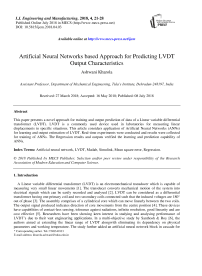Artificial neural networks based approach for predicting LVDT output characteristics
Автор: Ashwani Kharola
Журнал: International Journal of Engineering and Manufacturing @ijem
Статья в выпуске: 4 vol.8, 2018 года.
Бесплатный доступ
This paper presents a novel approach for training and output prediction of data of a Linear variable differential transformer (LVDT). LVDT is a commonly used device used in laboratories for measuring linear displacements in specific situations. This article considers application of Artificial Neural Networks (ANNs) for learning and output estimation of LVDT. Real-time experiments were conducted and results were collected for training of ANNs. The Regression results and outputs verified the learning and prediction capability of ANNs.
Artificial neural network, LVDT, Matlab, Simulink, Mean square error, Regression
Короткий адрес: https://sciup.org/15015853
IDR: 15015853 | DOI: 10.5815/ijem.2018.04.03
Список литературы Artificial neural networks based approach for predicting LVDT output characteristics
- Yu D, Ham S, Park J, Yun S. (2011). Analysis and design of LVDT. In Proceedings of IEEE 8th International Conference on Ubiquitous Robots and Ambient Intelligence (URAI), 23-26 Nov 2011, Incheon, South Korea, doi: 10.1109/URAI.2011.6146035.
- Masi A, Danisi A, Losito R, Mastino M, Spiezia G. (2010). Study of magnetic interference on a LVDT prototype. In Proceedings of IEEE International Conference on Instrumentation and Measurement Technology, 3-6 May 2010, Austin, USA, doi: 10.1109/IMTC.2010.5488091.
- Santhosh K.V., Roy B.K. (2012). An intelligent displacement technique using LVDT with an optimized ANN. Artificial Intelligent Systems and Machine learning, 4(8): 488-493.
- Joshi S, Harle S.M. (2017). Linear variable differential transducer (LVDT) & its application in Civil Engineering. International Journal of Transportation Engineering and Technology, 3(4): 62-66, doi: 10.11648/ijet.20170304.13.
- Masi A, Danzeca S, Losito R, Peronnard S.R., Spiezia G. (2014). A high precision radiation-tolerant LVDT conditioning module. Nuclear Instruments and Methods in Physics, 745: 73-81, doi: 10.1016/j.nima.2014.01.054.
- Santhosh K.V., Roy B.K. (2012). A smart displacement measuring technique using Linear variable displacement transducer. Procedia Technology, 4(2012): 854-861, doi: 10.1016/j.protcy.2012.05.140.
- Liu Y.T., Kuo Y.L., Yan D.W. (2017). System integration for on-machine measurement using a capacitive LVDT-like contact sensor. Advances in Manufacturing, 5(1): 50-58, doi: 10.1007/s40436-016-0169-y.
- Meydan T, Healey G.W. (1992). Linear variable differential transformer (LVDT): linear displacement transducer utilizing ferromagnetic amorphous metallic glass ribbons. Sensors and Actuators, 32(1-3): 582-587, doi: 10.1016/0924-4247(92)80047-7.
- Tian G.Y., Zhao Z.X., Bainer R.W., Zhang N. (1997). Computational algorithms for linear variable differential transformers (LVDTs). IEE Proceedings-Science, Measurement and Technology, 144(4): 189-192, doi: 10.1049/ip-smt:19971262.
- Muhammad U.K., Umar S. (2013). Sensitivity determination of Linear variable differential transducer (LVDT) in fluid level detection techniques. International Journal of Modern Engineering Sciences, 2(2): 73-83.
- Anandan N., George B. (2017). Design and development of a planar linear variable differential transformer for displacement sensing. IEEE Sensors Journals, 17(16): 5298-5305, doi: 10.1109/JSEN.2017.271.9101.
- Suresh V., Ramu G. (2012). Real time measurement of position as well as direction using linear variable differential transformer. International Journal of Engineering Research and Applications, 2(3): 246-252.
- Uhrig R.E. (1995). Introduction to artificial neural networks. In Proceedings of 21st IEEE International Conference on Industrial Electronics, Control and Instrumentation (IECON), 6-10 Nov 1995, Orlando, USA, doi: 10.1109/IECON.1995.483329.
- Bose B.K. (2001). Neural network applications in power electronics and motor drives-An introduction and perspective. IEEE Transaction on Industrial Electronics, 54(1): 14-33, doi: 10.1109/TIE.2006.888683.
- Shi L., Wang X.C. (2010). Artificial neural networks: current applications in modern medicine. In Proceedings of IEEE International Conference on Computer and Communication Technologies in Agriculture Engineering (CCTAE), 12-13 June 2010, Chengdu, China, doi: 10.1109/CCTAE.2010.5543470.
- Bhuvaneswari S., & Sabarathinam, J. (2013). Defect analysis using artificial neural network. International Journal of Intelligent Systems and Applications, 6(5): 33-38, doi: 10.5815/ijisa.2013.05.05.
- Al-Maqaleh B.M., Al-Mansoub A.A., & Al-Badani F.N. (2016). Forecasting using Artificial neural network and statistics models. International Journal of Education and Management Engineering, 6(3): 20-32, doi:10.5815/ijeme.2016.03.03.
- Kumar K., & Abhishek (2012). Artificial neural network for diagnosis of kidney stone disease. International Journal of Information Technology and Computer Science, 5(7): 20-25, doi: 10.5815/ijitcs.2012.07.03.
- Duranton M. (1996). Image processing by neural networks. IEEE Micro, 16(5): 12-19, doi: 10.1109/40.540076.
- Baptista, D., & Morgad-Dias, F. (2013). A Survey of artificial neural network training tools. Neural Computing and Applications. 23(3-4):609-615, doi: 10.1007/s00521-013-1408-9.
- Liu H, Cocea M. (2017). Semi-random partitioning of data into training and test sets in granular computing context. Granular Computing, 2(4): 357-386, doi: 10.1007/s41066-017-0049.
- Jayne C, IIiads L, Mladenov V. (2016). Special issue on the engineering applications of neural networks. Neural Computing and Applications. 27(5): 1075-1076, doi: 10.1007/s00521-016-2318-4.
- Zhao S.J., Xu Y.M. (2004). Levenberg-Marquardt algorithm for nonlinear principal component analysis neural network through inputs training. In Proceeding of IEEE Fifth World Congress on Intelligent Control and Automation, 15-19 June 2004, Hangzhou, China, doi: 10.1109/WCICA.2004.1343139.
- Dao-de S. (2000). Selection of the linear regression model according to the parameter estimation. Wuhan University Journal of Natural Science, 5(4): 400-405, doi: 10.1007.BF0285076.


